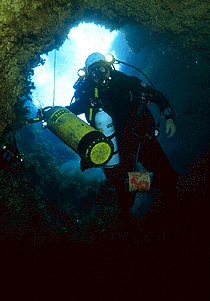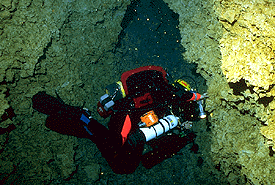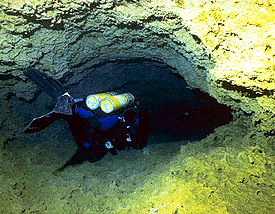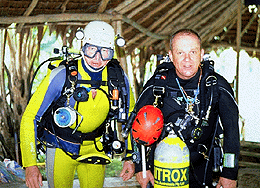 |
Cave Diving |
 Cave diving is the newest addition to our business. Aquamarine has adopted the standards of the CDAA (Cave Diving association of Australia). All cave dives have been graded from Cavern, Sinkhole, Cave, and Penetration level. Divers will be required to hold the relevant cave qualifications to dive the sites. Divers not sure or qualified under a different qualification system should contact Aquamarine prior to arrival.
Cave diving is the newest addition to our business. Aquamarine has adopted the standards of the CDAA (Cave Diving association of Australia). All cave dives have been graded from Cavern, Sinkhole, Cave, and Penetration level. Divers will be required to hold the relevant cave qualifications to dive the sites. Divers not sure or qualified under a different qualification system should contact Aquamarine prior to arrival.
Divers endorsed for Nitrox diving may use Nitrox as a diving or deco mix. It is recommended that cave divers bring all their own equipment required to dive except cylinders and weights and belt, this would include Nitrox clean regulators etc.
Only since 1994 has cave diving been discovered in Vanuatu. 1996 was the first real exploration attempt to see if the caves were worth further exploration and to rate and categorize the caves and establish the potential for serious cave diving. It didn't take too long before the very experienced
cave exploration team were excited about new discoveries of a world class cave system and the potential of many more cave to be discovered.
 It's difficult to think that in the world as we know it, and after space ships have been to the moon and now Mars, we are still discovering places on this earth that no man has seen before.
It's difficult to think that in the world as we know it, and after space ships have been to the moon and now Mars, we are still discovering places on this earth that no man has seen before.
In early 1997 the second exploration team returned to explore more caves that had been earmarked on the previous expedition. They were looking for the source of the Sarakata River, the main river and water supply to the small town Luganville. After hours of mountain goat country and thick bush
and jungle the source was found, now it had to be dived. It takes a team of at least four people to help carrying all the equipment in to get only one diver in the water. It was like a team of ants carrying food back to their nest. The first few dives encounted a very interesting cave system. A maximum of 30m (100') with a large internal area going on forever. On this expedition this cave was explored and mapped to 495m (1609'). Further exploration was proving difficult as there was a constant but very slight current to work against moving in and air use rules were at almost maximum. Another trip with more equipment was needed.
Late 1997 saw the next group arrived. This time a small four man team with underwater scooters and an attitude for adventure and exploration. The main task was to see how far this Sarakata cave system would go and map what was done. Would it go only another 10m from the last team's exploration and be
allot of work for nothing ? or would we be finding a cave system that would put Vanuatu on the map for some of the best cave diving in the world ?.
 Our first dive manned with the UPV's took us quickly to the end of the line where the last team had got to 495m. From there we were only able to lay another 20m of line. The next dive took the line another 70m into an air cave area about 40m long and 10m wide with a ceiling of 10m. The next dive went passed this point back under the water for another 30m and up into another air cave. This cave with the flow of water constantly running though went for 200m before again disappearing back underground. Our last and final dive took us a total of 1204m (3913') under ground and over 4 hours in the cave system, we were involved in a serious cave system which at 1204m was getting bigger with no signs of ending,. In the direction it was heading, no known surface water was anywhere to be found.
Our first dive manned with the UPV's took us quickly to the end of the line where the last team had got to 495m. From there we were only able to lay another 20m of line. The next dive took the line another 70m into an air cave area about 40m long and 10m wide with a ceiling of 10m. The next dive went passed this point back under the water for another 30m and up into another air cave. This cave with the flow of water constantly running though went for 200m before again disappearing back underground. Our last and final dive took us a total of 1204m (3913') under ground and over 4 hours in the cave system, we were involved in a serious cave system which at 1204m was getting bigger with no signs of ending,. In the direction it was heading, no known surface water was anywhere to be found.
Within this cave is also many opportunities for more detailed mapping and exploration. Numerous opportunities were seen as we passed through the 1204m. Many more dives are needed to explore this and the many other caves in this region and the special thing is to this date only a hand full of divers have seen the beauty and had that unique feeling of discovery.
Cave diving in this area is now open to all certified cave divers. For groups of four or more, guided tours can be arranged through Aquamarine Ltd. The countryside surrounding the caves is also very beautiful and non-divers can enjoy a day in the country as well. Accommodation, tours, and diving packages are now available. For more information on the "Santo Caves" we have links to the following sites with photos and stories that will interest you. These caves are at the birth of new discovery, and if you would like to part of this adventure don't wait until everyone but you have dived them, be one of the first in the world to see these unique cave systems. When we started diving these caves we thought we had some interesting dives that would compliment diving the President Coolidge, what we have now is a cave system attraction in it's own right.
Technical Diving...
 Aquamarine also offers technical diving for divers interested and or qualified in NITROX and CAVE diving. Courses are offered and can be arranged with prior notice. Nitrox at 50% is regularly used as a DECO gas for diving the President Coolidge, however all mixes can be made for divers certified in Nitrox diving. Aquamarine is a TDI facility. Divers intending to use Nitrox should advise Aquamarine prior to arrival. It is also advised that divers bring all required equipment such as Nitrox clean regulators, and twin tank bands. All cylinders and weights are supplied.
Aquamarine also offers technical diving for divers interested and or qualified in NITROX and CAVE diving. Courses are offered and can be arranged with prior notice. Nitrox at 50% is regularly used as a DECO gas for diving the President Coolidge, however all mixes can be made for divers certified in Nitrox diving. Aquamarine is a TDI facility. Divers intending to use Nitrox should advise Aquamarine prior to arrival. It is also advised that divers bring all required equipment such as Nitrox clean regulators, and twin tank bands. All cylinders and weights are supplied.
Home |
Aquamarine |
Services |
President Coolidge |
Dive Sites |
Vanuatu
Meet Boris |
Bookings


Cave diving is the newest addition to our business. Aquamarine has adopted the standards of the CDAA (Cave Diving association of Australia). All cave dives have been graded from Cavern, Sinkhole, Cave, and Penetration level. Divers will be required to hold the relevant cave qualifications to dive the sites. Divers not sure or qualified under a different qualification system should contact Aquamarine prior to arrival.
It's difficult to think that in the world as we know it, and after space ships have been to the moon and now Mars, we are still discovering places on this earth that no man has seen before.
Our first dive manned with the UPV's took us quickly to the end of the line where the last team had got to 495m. From there we were only able to lay another 20m of line. The next dive took the line another 70m into an air cave area about 40m long and 10m wide with a ceiling of 10m. The next dive went passed this point back under the water for another 30m and up into another air cave. This cave with the flow of water constantly running though went for 200m before again disappearing back underground. Our last and final dive took us a total of 1204m (3913') under ground and over 4 hours in the cave system, we were involved in a serious cave system which at 1204m was getting bigger with no signs of ending,. In the direction it was heading, no known surface water was anywhere to be found.
Aquamarine also offers technical diving for divers interested and or qualified in NITROX and CAVE diving. Courses are offered and can be arranged with prior notice. Nitrox at 50% is regularly used as a DECO gas for diving the President Coolidge, however all mixes can be made for divers certified in Nitrox diving. Aquamarine is a TDI facility. Divers intending to use Nitrox should advise Aquamarine prior to arrival. It is also advised that divers bring all required equipment such as Nitrox clean regulators, and twin tank bands. All cylinders and weights are supplied.